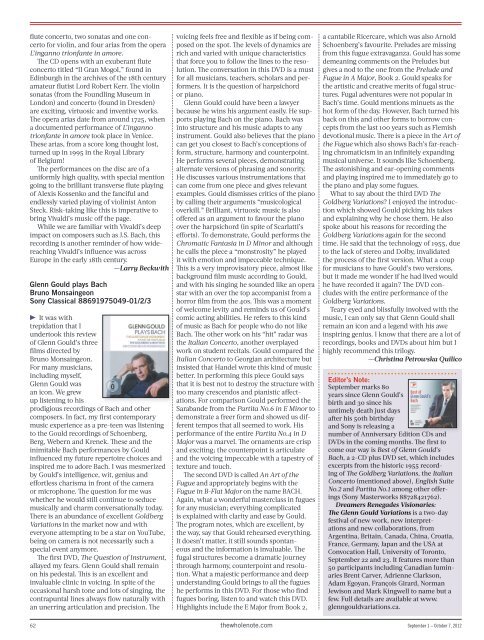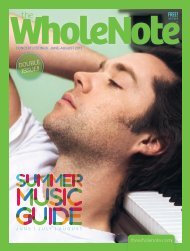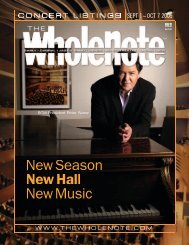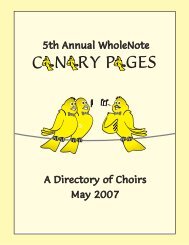PDF Version
PDF Version
PDF Version
- No tags were found...
You also want an ePaper? Increase the reach of your titles
YUMPU automatically turns print PDFs into web optimized ePapers that Google loves.
flute concerto, two sonatas and one concertofor violin, and four arias from the operaL’inganno trionfante in amore.The CD opens with an exuberant fluteconcerto titled “Il Gran Mogol,” found inEdinburgh in the archives of the 18th centuryamateur flutist Lord Robert Kerr. The violinsonatas (from the Foundling Museum inLondon) and concerto (found in Dresden)are exciting, virtuosic and inventive works.The opera arias date from around 1725, whena documented performance of L’ingannotrionfante in amore took place in Venice.These arias, from a score long thought lost,turned up in 1995 in the Royal Libraryof Belgium!The performances on the disc are of auniformly high quality, with special mentiongoing to the brilliant transverse flute playingof Alexis Kossenko and the fanciful andendlessly varied playing of violinist AntonSteck. Risk-taking like this is imperative tobring Vivaldi’s music off the page.While we are familiar with Vivaldi’s deepimpact on composers such as J.S. Bach, thisrecording is another reminder of how widereachingVivaldi’s influence was acrossEurope in the early 18th century.—Larry BeckwithGlenn Gould plays BachBruno MonsaingeonSony Classical 88691975049-01/2/3!!It was withtrepidation that Iundertook this reviewof Glenn Gould’s threefilms directed byBruno Monsaingeon.For many musicians,including myself,Glenn Gould wasan icon. We grewup listening to hisprodigious recordings of Bach and othercomposers. In fact, my first contemporarymusic experience as a pre-teen was listeningto the Gould recordings of Schoenberg,Berg, Webern and Krenek. These and theinimitable Bach performances by Gouldinfluenced my future repertoire choices andinspired me to adore Bach. I was mesmerizedby Gould’s intelligence, wit, genius andeffortless charisma in front of the cameraor microphone. The question for me waswhether he would still continue to seducemusically and charm conversationally today.There is an abundance of excellent GoldbergVariations in the market now and witheveryone attempting to be a star on YouTube,being on camera is not necessarily such aspecial event anymore.The first DVD, The Question of Instrument,allayed my fears. Glenn Gould shall remainon his pedestal. This is an excellent andinvaluable clinic in voicing. In spite of theoccasional harsh tone and lots of singing, thecontrapuntal lines always flow naturally withan unerring articulation and precision. Thevoicing feels free and flexible as if being composedon the spot. The levels of dynamics arerich and varied with unique characteristicsthat force you to follow the lines to the resolution.The conversation in this DVD is a mustfor all musicians, teachers, scholars and performers.It is the question of harpsichordor piano.Glenn Gould could have been a lawyerbecause he wins his argument easily. He supportsplaying Bach on the piano. Bach wasinto structure and his music adapts to anyinstrument. Gould also believes that the pianocan get you closest to Bach’s conceptions ofform, structure, harmony and counterpoint.He performs several pieces, demonstratingalternate versions of phrasing and sonority.He discusses various instrumentations thatcan come from one piece and gives relevantexamples. Gould dismisses critics of the pianoby calling their arguments “musicologicaloverkill.” Brilliant, virtuosic music is alsooffered as an argument to favour the pianoover the harpsichord (in spite of Scarlatti’sefforts). To demonstrate, Gould performs theChromatic Fantasia in D Minor and althoughhe calls the piece a “monstrosity” he playedit with emotion and impeccable technique.This is a very improvisatory piece, almost likebackground film music according to Gould,and with his singing he sounded like an operastar with an over the top accompanist from ahorror film from the 40s. This was a momentof welcome levity and reminds us of Gould’scomic acting abilities. He refers to this kindof music as Bach for people who do not likeBach. The other work on his “hit” radar wasthe Italian Concerto, another overplayedwork on student recitals. Gould compared theItalian Concerto to Georgian architecture butinsisted that Handel wrote this kind of musicbetter. In performing this piece Gould saysthat it is best not to destroy the structure withtoo many crescendos and pianistic affectations.For comparison Gould performed theSarabande from the Partita No.6 in E Minor todemonstrate a freer form and showed us differenttempos that all seemed to work. Hisperformance of the entire Partita No.4 in DMajor was a marvel. The ornaments are crispand exciting; the counterpoint is articulateand the voicing impeccable with a tapestry oftexture and touch.The second DVD is called An Art of theFugue and appropriately begins with theFugue in B-Flat Major on the name BACH.Again, what a wonderful masterclass in fuguesfor any musician; everything complicatedis explained with clarity and ease by Gould.The program notes, which are excellent, bythe way, say that Gould rehearsed everything.It doesn’t matter, it still sounds spontaneousand the information is invaluable. Thefugal structures become a dramatic journeythrough harmony, counterpoint and resolution.What a majestic performance and deepunderstanding Gould brings to all the fugueshe performs in this DVD. For those who findfugues boring, listen to and watch this DVD.Highlights include the E Major from Book 2,a cantabile Ricercare, which was also ArnoldSchoenberg’s favourite. Preludes are missingfrom this fugue extravaganza. Gould has somedemeaning comments on the Preludes butgives a nod to the one from the Prelude andFugue in A Major, Book 2. Gould speaks forthe artistic and creative merits of fugal structures.Fugal adventures were not popular inBach’s time. Gould mentions minuets as thehot form of the day. However, Bach turned hisback on this and other forms to borrow conceptsfrom the last 100 years such as Flemishdevotional music. There is a piece in the Art ofthe Fugue which also shows Bach’s far-reachingchromaticism in an infinitely expandingmusical universe. It sounds like Schoenberg.The astonishing and ear-opening commentsand playing inspired me to immediately go tothe piano and play some fugues.What to say about the third DVD TheGoldberg Variations? I enjoyed the introductionwhich showed Gould picking his takesand explaining why he chose them. He alsospoke about his reasons for recording theGoldberg Variations again for the secondtime. He said that the technology of 1955, dueto the lack of stereo and Dolby, invalidatedthe process of the first version. What a coupfor musicians to have Gould’s two versions,but it made me wonder if he had lived wouldhe have recorded it again? The DVD concludeswith the entire performance of theGoldberg Variations.Teary eyed and blissfully involved with themusic, I can only say that Glenn Gould shallremain an icon and a legend with his aweinspiring genius. I know that there are a lot ofrecordings, books and DVDs about him but Ihighly recommend this trilogy.—Christina Petrowska QuilicoEditor’s Note:September marks 80years since Glenn Gould’sbirth and 30 since hisuntimely death just daysafter his 50th birthdayand Sony is releasing anumber of Anniversary Edition CDs andDVDs in the coming months. The first tocome our way is Best of Glenn Gould’sBach, a 2-CD plus DVD set, which includesexcerpts from the historic 1955 recordingof The Goldberg Variations, the ItalianConcerto (mentioned above), English SuiteNo.2 and Partita No.1 among other offerings(Sony Masterworks 88728421762).Dreamers Renegades Visionaries:The Glenn Gould Variations is a two-dayfestival of new work, new interpretationsand new collaborations, fromArgentina, Britain, Canada, China, Croatia,France, Germany, Japan and the USA atConvocation Hall, University of Toronto,September 22 and 23. It features more than50 participants including Canadian luminariesBrent Carver, Adrienne Clarkson,Adam Egoyan, François Girard, NormanJewison and Mark Kingwell to name but afew. Full details are available at www.glenngouldvariations.ca.62 thewholenote.com September 1 – October 7, 2012
















